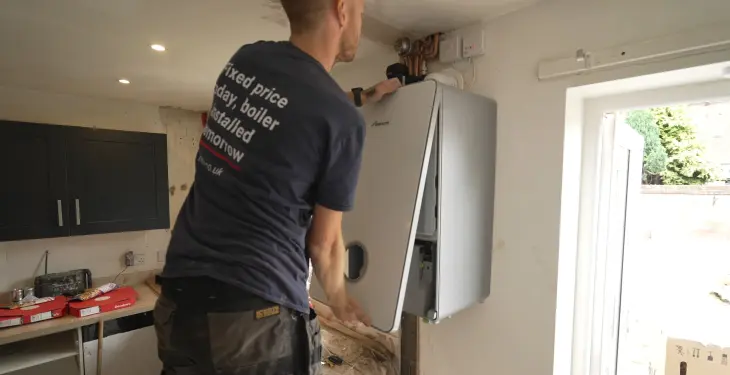

Written by Stephen Day
Gas Safe Engineer
Updated: 30th May, 2025
Understanding the perfect heat pump size for your UK home is vital for efficiency and comfort. From square footage and insulation to climate and appliance considerations, our comprehensive guide simplifies the complexities of heat pump sizing and discusses potential financial incentives.
Get a new boiler quote, save up to £550 per year (0% APR available).
Heat pumps are versatile systems that transfer heat from one place to another instead of generating it, which makes them efficient in both heating and cooling.
Here’s a look at the primary types and components to understand how these systems work.
Air-to-Air Heat Pumps (ASHPs): Air-to-air heat pumps extract heat from the outside air and transfer it indoors during the winter, reversing the process in the summer to cool the home. They work well in moderate climates and are available in both ducted and ductless (mini-split) configurations.
Ground Source Heat Pumps (GSHPs): Also known as geothermal heat pumps, GSHPs draw heat from the ground, where temperatures remain relatively stable. These systems can be more energy-efficient than ASHPs but require more extensive installation, often involving pipes buried underground in a horizontal or vertical loop.
Water Source Heat Pumps: These water source systems work by transferring heat to and from a water source, such as a lake or river, but are typically less common in residential settings due to geographical constraints.
Compressor: This is the engine of the heat pump, compressing the refrigerant to raise its temperature and facilitate heat transfer.
Condenser: Releases absorbed heat. In heating mode, it transfers warmth to indoor air; in cooling mode, it removes heat from the refrigerant to cool the space.
Evaporator: Absorbs heat from the environment (air or ground) and transfers it to the refrigerant. It pulls heat from outdoor air or the ground during winter and from indoor air in the summer.
Expansion Valve: Regulates the flow of refrigerant, ensuring appropriate temperatures and pressures within the system.
Understanding these components will help you make an informed decision on the right system for your home, ensuring optimal performance and energy savings throughout the year.
When selecting the appropriate size of a heat pump for your home, it’s essential to assess several factors that impact efficiency and comfort.
A home’s size and insulation quality directly influence heat pump efficiency. A well-insulated home retains heat better, requiring a smaller system, while a poorly insulated home may need a larger pump to maintain comfort. Consider adding or upgrading insulation for optimal efficiency before finalizing your heat pump size.
The climate zone where you live will significantly impact the heat pump size. Homes in areas with extreme temperature variations may require a higher-capacity system to accommodate the additional heating or cooling demands.
Windows and household appliances can contribute to a home’s overall heat load. For example, south-facing windows with ample sunlight may increase indoor heat, while appliances like ovens and dryers add to heat levels. These factors should be incorporated into your heat pump sizing decisions, as they can impact the unit’s efficiency.
The condition of your home’s ductwork can also influence the heat pump’s performance. Poorly sealed or undersized ducts can hinder heat distribution, increasing your energy use. Ensure your ductwork is in good condition or consider ductless systems if ducts aren’t feasible.
Taking each of these factors into account is essential to choosing the right size heat pump for optimal comfort, efficiency, and performance.
There are several methods for calculating the proper heat pump size. We’ll review the most common approaches, including Manual J calculations and online calculators.
The Manual J Calculation is a detailed assessment of a home’s heating and cooling needs. This method considers:
Square footage and room dimensions
Climate zone and temperature range
Insulation levels
Window types, sizes, and orientation
Ductwork, occupancy, and energy load from appliances
Professionals use this calculation to determine the BTU or tonnage required to meet your home’s specific needs, ensuring a system that maintains efficiency without overworking. A properly sized heat pump will prevent issues like short cycling, where the system frequently turns on and off, reducing its lifespan.
Online calculators can give you a rough estimate of the heat pump size needed for your home. They typically require data on:
Home square footage
Insulation quality
Window orientation and types
Climate zone
While convenient, online calculators may not account for all variables, making them less precise than a Manual J Calculation. If you’re relying on an online calculator, use it as a guideline, and consider a professional assessment for added accuracy.
BTUs measure heat output, and most heat pumps are rated in BTUs or tons. In general, one ton equals 12,000 BTUs. Here’s a quick guideline based on square footage:
500-600 sq. ft.: 1.5 tons (18,000 BTUs)
600-1000 sq. ft.: 2 tons (24,000 BTUs)
1000-1500 sq. ft.: 2.5 tons (30,000 BTUs)
1500-2000 sq. ft.: 3 tons (36,000 BTUs)
These are starting points and can be adjusted based on other factors like insulation, windows, and local climate.
The right size heat pump balances efficiency and cost, as higher efficiency systems may cost more upfront but save you money in the long term.
Three key ratings help gauge a heat pump’s efficiency:
SEER (Seasonal Energy Efficiency Ratio): Measures cooling efficiency; higher SEER ratings mean better performance.
HSPF (Heating Seasonal Performance Factor): Rates heating efficiency; higher HSPF indicates greater energy efficiency.
EER (Energy Efficiency Ratio): Measures cooling efficiency in a steady climate.
While higher efficiency models have higher initial costs, they can reduce energy expenses significantly over time.
Higher efficiency models come at a premium, but the savings in energy bills over the years can offset this. Here are some considerations:
Local Climate and Utility Costs: Colder regions benefit more from high-efficiency heat pumps as they see significant energy use during winter.
Incentives and Rebates: Many governments offer incentives for energy-efficient systems, which can help lower costs.
Home Energy Use: Homes with consistent heating or cooling needs can save more with a high-efficiency model.
Balancing efficiency with upfront costs requires careful planning, but the right investment can yield lasting savings and comfort.
If you’re adding a heat pump to an existing system, compatibility and function should be top priorities.
Different HVAC systems have unique requirements:
Boilers: A heat pump can provide cooling in summer if your home relies on a boiler for heat. However, switching completely to a heat pump may require reconfiguring your heating setup.
Central Air Conditioning: Heat pumps can replace central AC systems, offering both heating and cooling, making them a convenient choice.
Consider your home’s layout and needs before replacing an entire system, and consult an HVAC expert for advice on compatibility.
Choosing the right contractor is crucial to ensure proper installation and functionality.
Look for experience in heat pump installation and maintenance, and check for certifications. Reliable contractors should also have positive customer reviews and references.
Get multiple quotes to compare prices and service quality. A quote should include labor, equipment, and any additional costs, such as modifications to ductwork or wiring.
A reputable contractor should explain the installation process, keep you informed, and answer any questions. Proper installation is key to efficient performance and preventing costly repairs.
A well-sized heat pump provides multiple benefits, from cost savings to a more comfortable home environment.
An efficient heat pump meets your home’s needs without excessive energy use. This helps lower your energy bills, especially in regions with high utility costs.
A properly sized heat pump keeps temperatures and humidity levels balanced, avoiding uncomfortable hot and cold spots.
Right-sized systems avoid excessive wear and tear, which can extend their lifespan and reduce the likelihood of repairs.
Properly sizing a heat pump is an investment in comfort, efficiency, and long-term savings.
In the UK, various incentives make heat pump installation more affordable:
BUS offers grants to help with heat pump installation costs. These grants include:
Air Source Heat Pumps: £5,000 grant
Ground Source Heat Pumps: £6,000 grant
With £450 million in funding available, BUS aims to make low-carbon heating options accessible to more homes.
Some utilities offer rebates or credits for energy-efficient installations, helping offset costs. Check with your local provider to see if you qualify.
Energy-efficient homes may qualify for discounts on home insurance premiums, depending on the provider and other factors.
Last updated: 30th May, 2025

Written by Stephen Day
Gas Safe Engineer at iHeat
Stephen Day is a Gas Safe registered and FGAS certified engineer with over 20 years of hands-on experience in the heating, cooling, and renewable energy industry, specialising in boiler installations, air conditioning, and heat pump systems.
LinkedInArticles by Stephen Day are reviewed by iHeat’s technical team to ensure accuracy and reliability.

22nd December, 2025
Based on data from over 7000 boiler installations completed by iHeat in the past 12 months...
 Read Article
Read Article

22nd December, 2025
Here’s a quick roundup of the best combi boilers for 2026.
 Read Article
Read Article

22nd December, 2025
When your old boiler breaks down and it comes time to replace it with a new one, it might...
 Read Article
Read Article
No obligation. Takes less than 60 seconds.